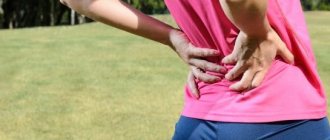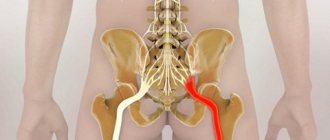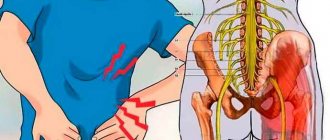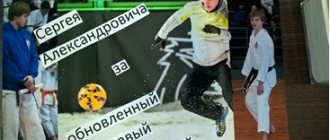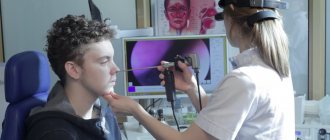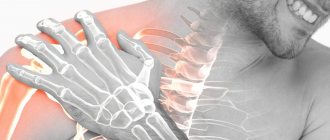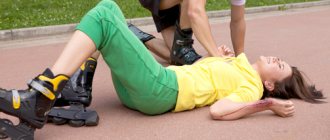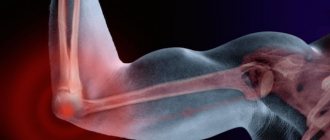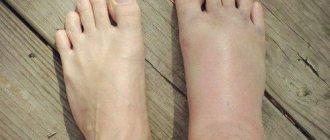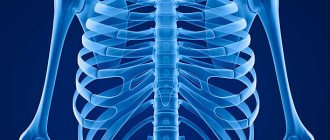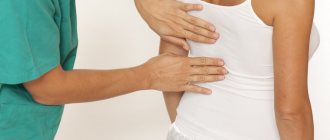De Quervain's tenosynovitis is a painful inflammation of the tendons at the base of the thumb. This process involves the tendons of the extensor pollicis brevis and abductor pollicis longus muscles. These muscles are located on the dorsal surface of the forearm and pass to the lateral side of the thumb through the fibro-osseous tunnel formed by the styloid process of the radius and the extensor retinaculum. Pain, which is the main complaint in this disease, occurs with abduction of the thumb, grasping movements and ulnar deviation of the hand. Swelling and hardening of the tissue may also be present.
Clinically Relevant Anatomy
Clinically Relevant Anatomy
Extensor pollicis brevis
- Beginning: ½ of the posterior surface of the body of the radius, interosseous septum of the forearm.
- Attachment: base of the proximal phalanx of the thumb.
- Functions: wrist joint: radial abduction;
- thumb: extension.
Abductor pollicis longus muscle
- Beginning: posterior surface of the radius and ulna, interosseous septum of the forearm.
- Attachment: base of the first metacarpal bone.
- Functions: wrist joint: radial abduction;
- thumb: abduction.
Etiology
- Currently, the cause of the disease is associated with myxoid degeneration (a process in which connective tissue is replaced by a gelatinous substance) rather than with acute inflammation of the synovium. In myxoid degeneration, there is excessive deposition of fibrous tissue and increased vascularization, which causes a thickening of the tendon sheath. This causes the extensor pollicis brevis and abductor pollicis longus muscles to become pinched.
- The main cause of the disease is repetitive movements in the wrist joint, especially those in which radial abduction of the thumb occurs with simultaneous extension and radial deviation of the wrist.
- The classic contingent of patients are mothers of newborns who constantly lift babies with a radially abducted thumb and wrist, moving from ulnar to radial deviation.
- The most common cause is chronic cumulative trauma.
- Cumulative injuries can occur from golfing, playing the piano, fly fishing, carpentry, or carrying a child for long periods of time. Also at risk are office workers and musicians.
- Repeated squeezing, grasping, clenching, squeezing or squeezing (when washing, for example) movements can cause inflammation of the tendons or their sheaths. This may lead to narrowing of the first dorsal compartment, resulting in a limitation in range of motion. If left untreated, inflammation and progressive narrowing (stenosis) can lead to scarring and subsequent restriction of movement of the thumb.
- In women, this disease occurs approximately 10 times more often than in men. Most often it occurs after the birth of a child and mainly occurs in women 30-50 years old. With the advent of new technologies and the proliferation of gadgets, it became known as “Blackberry Thumb Syndrome.”
Clinical picture
Clinical picture of de Quervain's tenosynovitis
The main complaint of patients is pain in the wrist on the side of the radius, which radiates to the forearm when trying to grab something with the thumb or straighten it. The pain is described as “constantly aching, burning, twitching.” Often the pain is aggravated when performing grasping, squeezing or twisting movements. Examination may reveal swelling in the area of the anatomical snuffbox, tenderness in the area of the styloid process of the radius, decreased range of motion in the first metacarpal joint, palpable thickening of the first dorsal compartment, and tendon crepitus. Other symptoms include weakness and paresthesia of the hand. These symptoms appear with a positive Finkelstein diagnostic test.
What to do if your hand hurts?
If you are worried about pain, whatever its cause, it is better not to waste time and get diagnosed. As a rule, the therapist prescribes a set of tests that identify the cause of the discomfort. Necessary:
- donate blood and urine for several indicators;
- undergo radiography or more visual MRI, CT;
- check the condition of the cardiovascular system.
When a specific ailment is identified, a specialized specialist writes a treatment regimen. If the problem is in the joints, they will most likely prescribe:
- anti-inflammatory;
- chondroprotectors;
- painkillers.
If an infection is detected, you will have to take a course of appropriate antibiotics. Gout requires the removal of excess uric acid and adjustments to the diet. If your hands go numb and hurt, then most often we are talking about tunnel syndrome, which requires reducing the load on the limb and taking care of the condition of the pinched nerve.
After the inflammation is stopped, physiotherapeutic procedures, massages, gymnastics, and swimming come in very handy. It is possible to use alternative medicine methods as complementary ones, but they must be approved by a doctor. Health needs to be taken care of, and even if pain in the hands occurs from time to time and does not cause much concern, undergoing a preventive examination and passing basic tests will not hurt. Many diseases that can be easily treated in the early stages only develop pain in an advanced state, when it is difficult to get rid of them. Therefore, you should not waste time.
We specialize in the treatment of the musculoskeletal system, even in severe stages of disease. We have been helping thousands of patients avoid surgery for 10 years!
Our doctors
This is the strongest team of experts who teach at the RUDN Department. We are the clinical base of leading universities, where the best doctors in Moscow, unique specialists from Russia and abroad are trained.
Survey
Inspection
Evaluation of a patient with signs and symptoms of de Quervain's tenosynovitis should begin with a thorough history followed by a physical examination.
History taking
- Overuse injury or acute injury.
- Have symptoms appeared before?
- Repetitive hand movements during work or daily activities.
- The pain is localized above the base of the thumb and in the dorsolateral region of the wrist near the styloid process of the radius.
- One hand dominance.
- Pregnancy or postpartum period.
Physical examination
Vital Signs
- Height.
- Weight.
- HELL.
- Pulse.
- NPV.
- Temperature (if required).
In a sitting position
- Resting hand/thumb position.
- Inflammation around the base of the finger on the dorsal side and/or near the styloid process of the radius.
Neurological examination
If you have symptoms such as numbness and tingling, as well as pain, it is necessary to conduct a neurological examination and check whether the symptoms are associated with pathology in the cervical spine. It is important to determine whether the central nervous system is involved in the process, whether the sensitivity of the skin at the base of the thumb and index finger is reduced (this area is innervated by the superficial branches of the radial nerve). Pay attention to a symptom such as hand weakness and determine whether it is due to pain or a neurological problem.
Dermatomes (C4-T1)
- Myotomes (C4-T1).
- Reflexes (C5, C6, C7).
- Pathological Hoffman reflex.
Palpation
During palpation, the most significant will be the detection of such a deviation as painful sensitivity over the base of the thumb and/or the 1st compartment of the wrist extensors above the styloid process of the radius. It is also possible to palpate the thickening of the synovial vagina. It is very important to rule out arthritis or a fracture of the scaphoid by palpating the first carpometacarpal joint to determine whether there is tenderness or deformity there.
- Dorsoradial region.
- Styloid process of the radius.
- “Anatomical snuffbox” - scaphoid, trapezius, extensor digitorum longus, extensor pollicis brevis, abductor pollicis longus and first carpometacarpal joint.
- Soft tissue surrounding the affected area.
Range of motion
Range of motion can also be used as a screening tool to rule out involvement of the cervical spine, proximal joints, and anatomical structures. Note any deviations in range of motion and be aware that when testing the thumb, there may be a clicking sound and a feeling of “sticking” in the thumb. All this is associated with reduced tendon mobility.
- Range of motion in the cervical spine.
- Flexion, extension, adduction and abduction of the shoulder (right and left).
- Flexion and extension in the elbow joint (right and left).
- Pronation and supination of the forearm (right and left).
- Wrist: Flexion, extension, ulnar and radial deviation.
- Fingers two to five:
- Abduction and adduction in the metacarpophalangeal joints.
- Flexion and extension (in the metacarpal, metacarpophalangeal and interphalangeal joints).
- Abduction and adduction (in the metacarpal-carpal, metacarpophalangeal joints).
- Opposition.
Muscle tests with resistance
In the presence of pain, strength naturally decreases. Note the maximum force possible in the absence of pain. This data will be useful in tracking the patient's progress during treatment.
- Grip strength.
- Pinch strength (finger squeezing force).
Muscle length
Watch for signs of hyper/hypomobility. Treatment will be prescribed based on dysfunction. Keep in mind that areas of hypomobility are often areas of referred pain.
- Congenital flexibility (clawed hand symptom).
- Extensors and flexors of the wrist.
Joint mobility
- Distal radioulnar joint.
- Wrist joint.
- Midcarpal joint.
- Thumb.
- Metacarpal, metacarpophalangeal and interphalangeal joints.
- Brush.
- Intercarpal joints.
Specific tests
Finkelstein test
- To confirm - Finkelstein test.
- To exclude: test for osteoarthritis of the first metacarpal joint (Grind Test);
- palpation to identify a scaphoid fracture;
- Upper Limb Tension Test, or ULTT B - to determine neuritis of the superficial sensory branch of the radial nerve;
- assessing the clinical likelihood of cervical radiculopathy;
- intercarpal instability.
Neurological tests
- Upper Limb Tension Test, or ULTT B.
- Test to detect damage to the radial nerve.
- Test to detect damage to the superficial sensory branch of the radial nerve.
- Tinel's sign.
Be careful with the position of your thumb while performing tests.
Circulation
- Pallor/Capillary refill.
- It is important to use the capsule-ligamentous apparatus in the acute phase of traumatic injury.
- Stress test of the collateral ligaments of the fingers (varus/valgus).
Operating principle
Manual spinal massage is based on ancient treatment techniques that came to us from the East. These include the following:
- techniques for working with soft tissues: skin, muscles, subcutaneous fat;
- work with joints;
- manipulation of tissues coming from the field of osteopathy;
- body-oriented therapy: relaxation techniques, removing tension;
- impact on the cervical spine;
- visceral therapy: work with putting internal organs in place.
Therapy can be combined with certain treatment methods: medication, surgery (after tissue healing). It is not recommended to accompany manual therapy with a number of methods that involve thermal effects - mud therapy, paraffin-ozokerite applications, physiotherapy.
Differential diagnosis
- Intercarpal instability. The wrist is a complex anatomical area consisting of a large number of small bones and ligaments. Degenerative processes or direct trauma can lead to instability between the articulating bones, which in turn leads to pathological changes in the biomechanics of the hand and the appearance of pain. Scapholunate dissociation, scaphotrapeziotrapezial joint degeneration, and lunate-triquetral dissociation can all be associated with radial wrist pain.
- Fracture of the scaphoid bone.
- Most often, a scaphoid fracture occurs as a result of a fall on an outstretched arm with an extended wrist. In this case, pain occurs on the side of the radius, there is also swelling in the area of the anatomical snuffbox, limited range of motion, pain when performing a movement, especially at the end of the amplitude. If the patient has been injured and subsequently experiences pain in the wrist from the side of the radius, then it is first necessary to exclude a fracture of the scaphoid bone.
- Damage to the superficial branches of the radial nerve (Wartenberg syndrome). The superficial branches of the radial nerve innervate the dorsal surface of the first and second fingers and the first interdigital space. Nerve fibers can become compressed between the extensor carpi radialis brevis and brachioradialis tendons due to scar tissue formation after injury or from wearing tight jewelry. As a result of compression, ischemia develops and, as a result, numbness and tingling in the area of innervation.
- Radiculopathy of the cervical spine at the C6 level. Compression of the spinal nerve roots can cause sensory disturbances, muscle weakness, and weakened reflexes. The key dermatomes of the C6 segment are the radius of the second metacarpal and the index finger, which is approximately the same area where pain occurs in de Quervain's syndrome. It is precisely because of the similarity of symptoms that it is important to exclude cervical radiculopathy and carefully check the C6 segment.
- Osteoarthritis of the first metacarpal joint. Osteoarthritis of the first metacarpal joint usually occurs in people over 50 years of age and usually manifests itself as stiffness of the joint in the morning, decreased range of motion, and tenderness in the area. With this disease, the squeeze test will be positive.
- Crossover syndrome. With this syndrome, pain will occur closer to the back of the forearm, mainly in the middle and about 5 cm below the wrist.
What to do if your hand hurts
27 bones, muscles, nerves, ligaments and tendons are the components of the human hand, thanks to the coordinated work of which we can perform a variety of actions. Nature has arranged all this quite compactly, but if some kind of trouble occurs with one of the parts of the system, the entire body suffers and the quality of human life is greatly deteriorated.
Pain syndrome can affect joints, bones, soft tissues, fingers; observed in individual parts of the upper limb or along the entire length of the arm. One or both limbs can hurt at the same time. Due to the fact that pain in the arm is caused by many diseases, a person has to turn to more than one specialist. It is quite possible that in addition to a therapist, you will need consultation:
- cardiologist;
- rheumatologist;
- traumatologist;
- surgeon;
- neurologist.
Treatment
The goal of treatment for de Quervain's tendonitis is to reduce pain caused by irritation and swelling.
Conservative treatment
The goal of nonsurgical treatment is to reduce pain and swelling. At the initial stage the following can be used:
- Immobilize the thumb or wrist joint with a splint or splint to rest the tendons. So far, clinicians have not reached a consensus on the duration of wearing orthoses: a number of experts recommend wearing them for 4-6 weeks, others recommend wearing them only during periods of pain.
- Avoiding repetitive movements and movements that aggravate the condition.
- Applying ice.
- Taking NSAIDs.
- Injections of corticosteroids into the synovial membranes.
- Physical therapy.
Patients may also be required to be immobilized for up to 6 weeks. To do this, use a bandage on the thumb. It was found that when wearing an orthosis, improvements occurred in 19% of cases. However, with simultaneous use of NSAIDs, this figure was even higher and amounted to 57%.
Ultrasound examination, according to some estimates, can have a positive effect on treatment results. In addition, it can act as a diagnostic tool. Injections administered under ultrasound guidance were more effective. In addition, there were no side effects. Ultrasound-guided injections performed into the extensor pollicis brevis area with septation are more effective than manual injection.
Another effective conservative treatment option is steroid injection, but more research is needed to establish its full benefits.
Direct injection of a small dose of cortisone into both tendons has worked well. For primary disease, the effectiveness of this measure is about 60-70%.
Treatment methods for neuritis
Neuritis must be treated. At the first signs of the disease, you should consult a neurologist. If treatment for neuritis is not started on time, the risk of developing paresis and muscle paralysis increases.
Treatment of neuritis is aimed, first of all, at eliminating the cause that caused it. If neuritis is of infectious origin, antibacterial therapy or antiviral drugs are used. If neuritis is of toxic origin, it is important to remove toxins from the body.
Drug treatment
In addition to antibacterial or antiviral drugs, the course of treatment for neuritis usually includes:
- B vitamins
- drugs that improve blood microcirculation
- drugs that increase the conductivity of nerve fibers
Massage
Massage of the muscles innervated by the affected nerve is recommended. Massage can be combined with heat therapy (infrared sauna).
More information about the treatment method
Physiotherapy
For neuritis, physical therapy methods such as electrophoresis, diadynamic therapy, SMT therapy, ultrasound therapy, magnetic therapy, and laser therapy can be used.
More information about the treatment method
Make an appointment Do not self-medicate. Contact our specialists who will correctly diagnose and prescribe treatment.
Rate how useful the material was
thank you for rating
Physical therapy
Friends, on July 17 in Moscow, as part of the #RehabTeam project, Anna Ovsyannikova’s seminar “Rehabilitation of the hand after a fracture of the distal radius (fracture of the “radius in a typical place”)” will take place.” Find out more... In addition, on July 18, she will conduct a seminar “Rehabilitation of the hand after fractures of the metacarpal bones (Boxer fracture).” Find out more...
Applying Ice/Heat
Heat can help relax tight muscles, and ice can help reduce inflammation of the extensor sheath.
Massage
Deep tissue massage in the area of the big toe can also help relax tight muscles, leading to less pain.
Stretching
You can also relax the tight muscles of the thumb eminence by stretching. This is facilitated by extension and abduction of the thumb.
Increased strength
- Finger extension with resistance.
- The position of the palm up is extension and abduction of the thumb.
- Thumb up - extension and abduction of the thumb.
- Radial deviation with resistance.
- Thumb up – supination with resistance.
- Thumb up – Opposing the thumb with resistance.
Increased range of motion
As mentioned above, stretching can help increase your range of motion. Applying ice/heat helps relax tight muscles, which also leads to increased range of motion.
Reduced swelling
The following measures may help reduce swelling:
- Thumb splinting.
- Corticosteroid injections.
- NSAIDs.
- Cold/warm.
- Massage.
- Stretching.
Exercises at home
Any of the stretching or strength-building exercises listed above can be incorporated into a home recovery program. At home, patients can also use ice packs or apply heat. After completing the training, patients can also perform self-massage at home.
To date, there have been no high-quality studies examining the effects of conservative treatment as a stand-alone intervention. The literature primarily describes the effects of corticosteroids and other injections compared with placebo. Studies that showed injections were better than splinting did not examine long-term results.
A Cochrane review states that there is “silver-level” evidence that corticosteroid injections are superior to splinting for pain relief. The authors, however, acknowledge that "the evidence is based on a short-term, very small, controlled clinical trial of low methodological quality that included only pregnant and breastfeeding women."
Walker presented a case study that examined the use of manual techniques in a patient with radial wrist pain. Although de Quervain's disease was immediately ruled out, the report advocated an approach using manual techniques. Particularly for the relief of pain and dysfunction in radial, radiocarpal, intercarpal and first metacarpal joint pain.
Ashurst described a case in which a patient diagnosed with de Quervain's disease was prescribed oral anti-inflammatory drugs, a brace, and relative rest. The patient wore the orthosis at night and was instructed to text as little as possible (a series of messages always preceded the onset of pain). This case supports the prescription of relative rest, in which the patient avoids aggravating movements but remains active.
Viikari-Juntura presented a literature review and found that wearing an orthosis is an essential component of the treatment of tenosynovitis. It was found that the use of an orthosis that allowed some movement was preferable to complete immobilization of the thumb. Rest from work, according to the survey, is neither necessary nor desirable. It was also found that heat, massage, and electrotherapy were not effective in improving the patient's physical capabilities.
